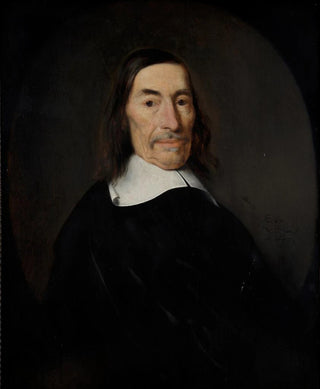Art print | Portrait of Jacob de Witt 1589-1674 - Nicolaes Maes


View from behind

Frame (optional)
Reproduction Portrait of Jacob de Witt 1589-1674 - Nicolaes Maes – Engaging Introduction
The "Portrait of Jacob de Witt" by Nicolaes Maes is an iconic 17th-century artwork, capturing the essence of a man whose impact on Dutch society of his time is undeniable. This painting, depicting the renowned statesman and man of letters, is much more than a simple physical representation. It embodies a prosperous period in Dutch history, where art and politics intertwine to produce timeless masterpieces. Contemplating this work, the viewer is transported into a universe where light and shadow play a crucial role, revealing the subtleties of Jacob de Witt's character while evoking the historical context in which he operated.
Style and uniqueness of the work
Nicolaes Maes, a pupil of Rembrandt, is distinguished by his ability to render light in a striking manner. In the "Portrait of Jacob de Witt," subtle nuances of the skin and meticulous details of the clothing demonstrate remarkable technical mastery. The composition is carefully orchestrated, with a dark background that emphasizes the commanding presence of the subject. Jacob de Witt's eyes, full of wisdom and determination, seem to scrutinize the viewer, establishing an intimate and direct connection. This painting does not merely depict a man; it tells a story, that of an intellectual engaged in the affairs of his time, and offers a glimpse into the values and aspirations of 17th-century Dutch society.
The artist and his influence
Nicolaes Maes, born in 1634 in Dordrecht, is often regarded as one of the masters of Dutch portraiture. His artistic journey is marked by a stylistic evolution that led him to develop a unique style, combining Rembrandt's influence with his own sensitivity. Maes was able to capture moments of life with rare emotional depth, and his portraits reveal not only the appearance of his subjects but also their psyche. As an artist active during a period of great cultural effervescence, he played a key role in establishing portraiture as a major artistic genre. His influence endures, inspiring generations of art

Matte finish

View from behind

Frame (optional)
Reproduction Portrait of Jacob de Witt 1589-1674 - Nicolaes Maes – Engaging Introduction
The "Portrait of Jacob de Witt" by Nicolaes Maes is an iconic 17th-century artwork, capturing the essence of a man whose impact on Dutch society of his time is undeniable. This painting, depicting the renowned statesman and man of letters, is much more than a simple physical representation. It embodies a prosperous period in Dutch history, where art and politics intertwine to produce timeless masterpieces. Contemplating this work, the viewer is transported into a universe where light and shadow play a crucial role, revealing the subtleties of Jacob de Witt's character while evoking the historical context in which he operated.
Style and uniqueness of the work
Nicolaes Maes, a pupil of Rembrandt, is distinguished by his ability to render light in a striking manner. In the "Portrait of Jacob de Witt," subtle nuances of the skin and meticulous details of the clothing demonstrate remarkable technical mastery. The composition is carefully orchestrated, with a dark background that emphasizes the commanding presence of the subject. Jacob de Witt's eyes, full of wisdom and determination, seem to scrutinize the viewer, establishing an intimate and direct connection. This painting does not merely depict a man; it tells a story, that of an intellectual engaged in the affairs of his time, and offers a glimpse into the values and aspirations of 17th-century Dutch society.
The artist and his influence
Nicolaes Maes, born in 1634 in Dordrecht, is often regarded as one of the masters of Dutch portraiture. His artistic journey is marked by a stylistic evolution that led him to develop a unique style, combining Rembrandt's influence with his own sensitivity. Maes was able to capture moments of life with rare emotional depth, and his portraits reveal not only the appearance of his subjects but also their psyche. As an artist active during a period of great cultural effervescence, he played a key role in establishing portraiture as a major artistic genre. His influence endures, inspiring generations of art






